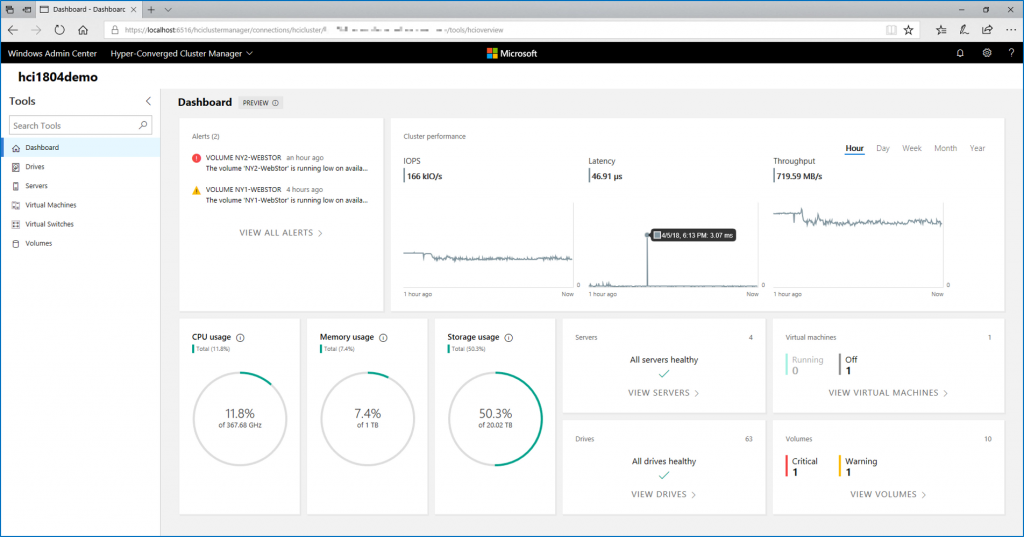Microsoft has released Windows Server 2019 with a new resiliency mode called nested resiliency. This mode enables to handle two failures in a two-node S2D cluster. Nested Resiliency comes in two flavors: nested two-way mirroring and nested mirror-accelerated parity. I’m certain that two-way mirroring is faster than nested mirror-accelerated parity but the first one provides only 25% of usable capacity while the second one provides 40% of usable capacity. After having discussed with some customers, they prefer improve the usable capacity than performance. Therefore, I should expect to deploy more nested mirror-accelerated parity than nested two-way mirroring.
Before Windows Server 2019, two-way mirroring (provide 50% of usable capacity) was mandatory in two-node S2D cluster. Now with Windows Server 2019, we have the choice. So, I wanted to compare performance between two-way mirroring and nested mirror-accelerated parity. Moreover, I want to know if compression and deduplication has an impact on performance and CPU workloads.
N.B: I executed tests on my lab which is composed of Do It Yourself servers. What I want to show is a “trend” to know what could be the bottleneck in some cases and if nested resiliency has an impact on performance. So please, don’t blame me in comment section 🙂
Test platform
I run my tests on the following platform composed of two nodes:
- CPU: 1x Xeon 2620v2
- Memory: 64GB of DDR3 ECC Registered
-
Storage:
- OS: 1x Intel SSD 530 128GB
- S2D HBA: Lenovo N2215
- S2D storage: 6x SSD Intel S3610 200GB
- NIC: Mellanox Connectx 3-Pro (Firmware 5.50)
- OS: Windows Server 2019 GA build
Both servers are connected to two Ubiquiti ES-16-XG switches. Even if it doesn’t support PFC/ETS and so one, RDMA is working (I tested it with test-RDMA script). I have not enough traffic in my lab to disturb RDMA without a proper configuration. Even if I implemented that in my lab, it is not supported and you should not implement your configuration in this way for production usage. On Windows Server side, I added both Mellanox network adapters in a SET and I created three virtual network adapters:
- 1x Management vNIC for RDP, AD and so one (routed)
- 2x SMB vNIC for live-migration and SMB traffics (not routed). Each vNIC is mapped to a pNIC.
To test the solution I use VMFleet. First I created volumes in two-way mirroring without compression, then I enabled deduplication. After I deleted and recreated volumes in nested mirror-accelerated parity without deduplication. Finally, I enabled compression and deduplication.
I run the VM Fleet with a block size of 4KB, an outstanding of 30 and on 2 threads per VM.
Two-Way Mirroring without deduplication results
First, I ran the test without write workloads to see the “maximum” performance I can get. My cluster is able to deliver 140K IOPS with a CPU workload of 82%.

In the following test, I added 30% of write workloads. The total IOPS is almost 97K for 87% of CPU usage.

As you can see, the RSS and VMMQ are well set because all Cores are used.

Two-Way Mirroring with deduplication
First, you can see that deduplication is efficient because I saved 70% of total storage.

Then I run a VMFleet test and has you can see, I have a huge drop in performance. By looking closely to the below screenshot, you can see it’s because of my CPU that reach almost 97%. I’m sure with a better CPU, I can get better performance. So first trend: deduplication has an impact on CPU workloads and if you plan to use this feature, don’t choose the low-end CPU.

By adding 30% write, I can’t expect better performance. The CPU still limit the overall cluster performance.

Nested Mirror-Accelerated Parity without deduplication
After I recreated volumes I run a test with 100% read. Compared to two-way mirroring, I have a slightly drop. I lost “only” 17KIOPS to reach 123KIOPS. The CPU usage is 82%. You can see also than the latency is great (2ms).

Then I added 30% write and we can see the performance drop compared to two-way mirroring. My CPU usage reached 95% that limit performance (but the latency is content to 6ms in average). So nested mirror-accelerated parity require more CPU than two-way mirroring.

Nested Mirror-Accelerated Parity with deduplication
First, deduplication works great also on nested mirror-accelerated parity volume. I saved 75% of storage.

As two-way mirroring with compression, I have poor performance because of my CPU (97% usage).


Conclusion
First, deduplication works great if you need to save space at the cost of a higher CPU usage. Secondly, nested mirror-accelerated parity requires more CPU workloads especially when there are write workloads. The following schemas illustrate the CPU bottleneck. In the case of deduplication, the latency always increases and I think because of CPU bottleneck. This is why I recommend to be careful about the CPU choice. Nested Mirror Accelerated Parity takes also more CPU workloads than 2-Way Mirroring.
Another interesting thing is that Mirror-Accelerated Parity produce a slightly performance drop compared to 2-Way Mirroring but brings the ability to support two failures in the cluster. With deduplication enabled we can save space to increase the usable space. In two-node configuration, I’ll recommend to customer Nested Mirror-Accelerated Parity by paying attention to the CPU.











Hi, thank you for sharing that.
Im deep in testing my new S2D W2K19 2-Way-Nested-Resilency-Mirror-Cluster (even hard to spell) 😉 and like compare the results given by my VMFLEET Tests.
Can you provide your chosen parameters vor the sweep tests please? like:
“.\start-sweep.ps1 -b 4 -t 4 -o 4 -w 10 -d 180”
Thank you.
Hello,
Sorry I can’t remember which settings I used. But Usually I use the following settings:
start-sweep -b 4 -t 2 -o 30 -w 30 -d 180